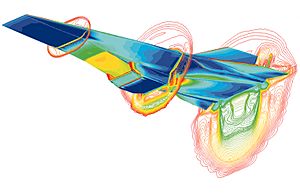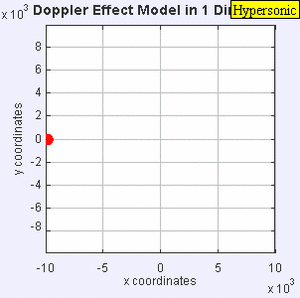Hypersonic speed facts for kids
Hypersonic speed is when something flies super fast, more than five times the speed of sound. We usually say it starts at Mach 5 and goes up from there.
The exact speed where something becomes "hypersonic" can change. This is because the air around a fast-moving object starts to behave differently. For example, air molecules can break apart or become electrically charged. These changes become really important when speeds are between Mach 5 and Mach 10.
Contents
What Makes Hypersonic Flow Special?
It can be tricky to say exactly when a flow becomes hypersonic. There isn't a clear line between supersonic and hypersonic speeds. However, when something flies at hypersonic speeds, certain things happen to the air that we can't ignore anymore.
Here are some special things that happen in hypersonic flow:
- Shock layer: A very hot and dense layer of air forms around the object.
- Aerodynamic heating: The object gets extremely hot because of friction with the air.
- Entropy layer: The air flow becomes very swirly and mixed up.
- Real gas effects: The air itself changes, like molecules breaking apart.
- Low density effects: How the air behaves can be different in very thin air.
- Aerodynamic coefficients stay the same: The way air pushes on the object doesn't change much with speed at very high Mach numbers.
How Air Behaves at High Speeds
When an object goes faster and faster, the air in front of it gets squeezed more. This creates a shock wave. At hypersonic speeds, this shock wave gets very close to the object. This is because the air behind the shock wave becomes much denser.
Why Does it Get So Hot?
When an object moves very fast through the air, a lot of its movement energy turns into heat. This happens because of friction and other effects in the air. This heat makes the air around the object extremely hot.
Because of these high temperatures, the air molecules can start to vibrate, break apart, or even become electrically charged. This creates a lot of heat that can transfer to the object, making it glow or even melt if not protected.
Different Speed Zones
Scientists often divide speeds into different "regimes" or zones. Even though "subsonic" means slower than sound and "supersonic" means faster, these terms also refer to specific ranges of Mach numbers.
For example, there's a "transonic regime" around Mach 1. In this zone, the air flow is very complex. This is why planes designed for these speeds have special shapes.
NASA defines "high" hypersonic speeds as Mach 10 to Mach 25. Speeds faster than Mach 25 are called "re-entry speeds." Spacecraft like the Soyuz and Dragon capsules, and the old Space Shuttle, fly at these re-entry speeds. New spacecraft like Starship are also designed for these very high speeds.
Here's a table showing the different speed zones:
| Speed Zone | Speed | What Kind of Aircraft Fly Here? | |||
|---|---|---|---|---|---|
| Mach No | mph | km/h | m/s | ||
| Subsonic | < 0.8 | < 614 | < 988 | < 274 | Most passenger planes and propeller planes. They often have long, thin wings and rounded noses. |
| Transonic | 0.8–1.2 | 614–921 | 988–1482 | 274–412 | Planes that fly near the speed of sound. They often have swept-back wings to help reduce drag. |
| Supersonic | 1.2–5 | 921–3836 | 1482–6174 | 412–1715 | Aircraft designed to fly faster than sound. They have sharp edges and thin wings. Examples include fighter jets like the F-104 Starfighter and the Concorde passenger jet. |
| Hypersonic | 5–10 | 3836–7673 | 6174–12350 | 1715–3430 | Aircraft with special metal skins (like nickel or titanium) that can handle heat. Their design is very complex because every part affects the air flow around the whole craft. Examples include the Boeing X-51 Waverider and some missiles. |
| High-Hypersonic | 10–25 | 7673–19180 | 12350–30870 | 3430–8507 | Heat control is super important. These vehicles need special heat shields or materials that can get very hot. The air can even cause parts of the vehicle's skin to wear away. Examples include the Hypersonic Technology Vehicle 2 and some very fast missiles. |
| Re-entry speeds | > 25 | > 19030 | > 30870 | > 8575 | Spacecraft returning from space. They use thick heat shields to protect them from extreme heat. They often have a blunt, rounded shape and small or no wings. |
How Scientists Study Hypersonic Flow
To understand how things fly at hypersonic speeds, scientists use special ways to group similar situations together. For slower speeds, they mostly look at the Mach number (how fast compared to sound) and the Reynolds number (how sticky the air is).
But for hypersonic speeds, other things become important. For example, the air gets so hot that it starts to change its chemical makeup. This means that studying hypersonic flight is often called "aerothermodynamics" instead of just "aerodynamics" because heat and chemical changes are a big part of it.
Scientists also need to consider many more details to describe the air at these speeds. This makes studying and designing hypersonic vehicles very challenging!
Different Hypersonic Zones
Hypersonic flow can be divided into a few different zones, even though the lines between them are not always perfectly clear.
Perfect Gas Zone
In this zone, which is roughly from Mach 5 to Mach 10-12, the air still behaves like a simple gas. However, how heat moves to the object becomes very important.
Dissociated Gas Zone
When speeds get even higher, the gases in the air (like nitrogen and oxygen) start to break apart into smaller pieces as they hit the shock wave. The type of material the object is made of also matters here, as it can affect how much heat is transferred. This zone starts when gases begin to break apart, which for nitrogen is around 2000 Kelvin (very hot!).
See also
 In Spanish: Velocidad hipersónica para niños
In Spanish: Velocidad hipersónica para niños
- Supersonic transport
- Lifting body
- Atmospheric entry
- Hypersonic flight
- DARPA Falcon Project
- Reaction Engines Skylon (design study)
- Reaction Engines A2 (design study)
- HyperSoar (concept)
- X-51 A Waverider
- X-20 Dyna-Soar (cancelled)
- Rockwell X-30 (cancelled)
- Avatar RLV (2001 Indian concept study)
- Hypersonic Technology Demonstrator Vehicle (Indian project)
- Ayaks (Russian wave rider project from the 1990s)
- Avangard (Russian hypersonic glide vehicle, in service)
- DF-ZF (Chinese hypersonic glide vehicle, operational)
- Lockheed Martin SR-72 (Planned)
- Engines
- Rocket engine
- Ramjet
- Scramjet
- Reaction Engines SABRE, LAPCAT (design studies)
- Missiles
- Shaurya (missile) Ballistic Missile -
 India (Entered Production)
India (Entered Production) - BrahMos-II Cruise Missile -

 (Under Development)
(Under Development) - 9K720 Iskander Short-range ballistic missile
 Russia (Currently In Service)
Russia (Currently In Service) - 3M22 Zircon Anti-ship hypersonic cruise missile
 (in production)
(in production) - R-37 (missile) Hypersonic air-to-air missile
 (in service)
(in service) - Kh-47M2 Kinzhal Hypersonic air-launched ballistic missile
 (in service)
(in service)
- Other flow regimes



